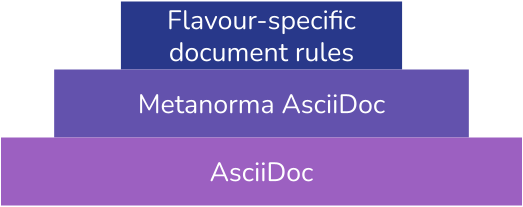What is Metanorma?
Metanorma is three things in one:
- Software
-
The Metanorma toolchain is the software that you use to create documents and generate output.
- Document metamodels
-
Metanorma provides a document structure for standardization documents, specified in ISO 36001. Since each organization has different requirements for their standard documents, they use a "flavor" of Metanorma. A flavor is a document model that provides additional metadata to reflect the SDO’s needs.
- XML schemas
-
To use the defined document metamodels, there needs to be a machine-readable file so that documents can be checked against their intended structure.
Metanorma consists of several layers of complexity, see the figure below.
The basis for each metanorma document is AsciiDoc. Since AsciiDoc itself has limited functionalities for authoring standards, Metanorma extends AsciiDoc as one part of the Metanorma toolchain (1). Metanorma AsciiDoc provides advanced features, such as automatically linking the correct standard in a bibliography section.
The final layer of complexity are flavour-specific document rules and best practices based on the document metamodels (2). For example, ISO documents must include a "Scope" section, whereas NIST requires an "Acknowledgements" section.

Metanorma has many advantages for authoring standards:
-
Metanorma supports the needs of many standardization organizations, such as ISO, IETF, and many more.
-
Metanorma can be extended with new document models (flavors).
-
It uses the "what you see is what you mean" (WYSIWYM) approach based on AsciiDoc.
-
You can style your content differently, depending on the output.
-
The document models ensure complete and consistent standard documents that follow the rules of your organization.
-
Metanorma can create long and complex documents without them becoming corrupted.
-
Metanorma enables dynamic integration of external data into documents.